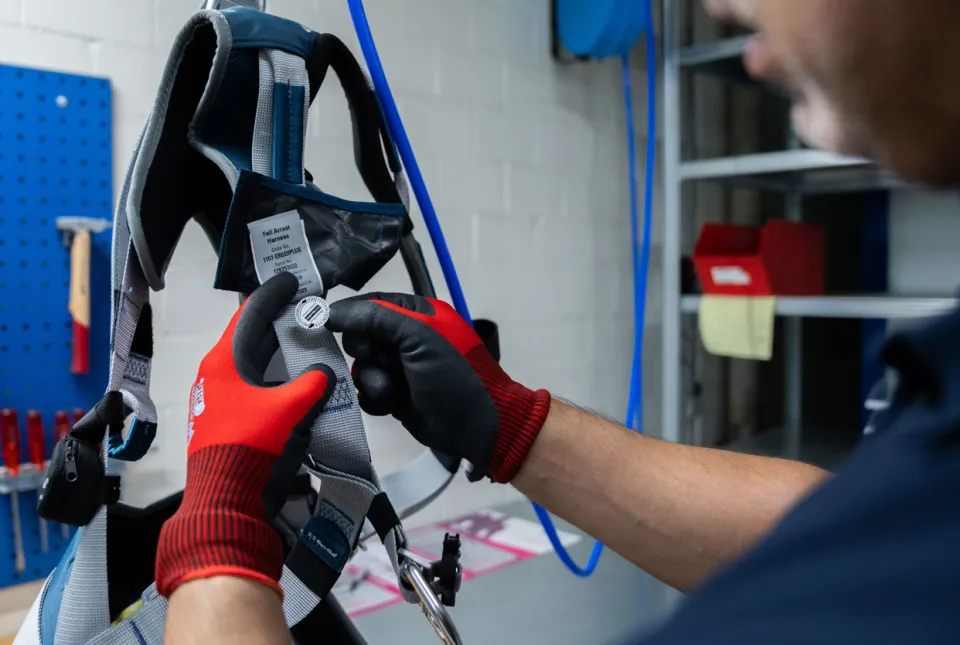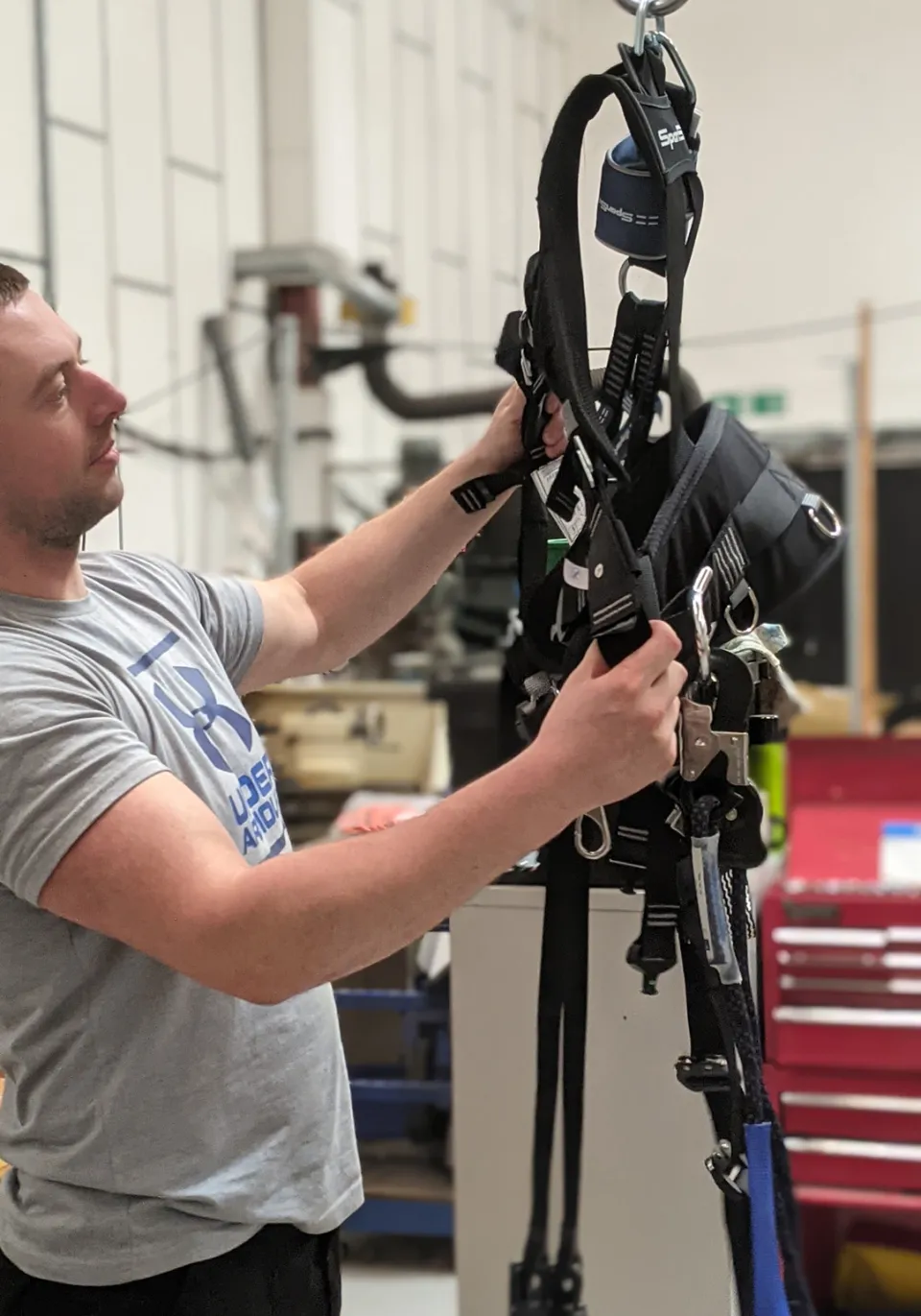
Equipment Inspections and Record Keeping
Why? How Often? Who by?
Why do items of Fall Protection and Lifting Equipment need to be inspected?
Legal requirements:
The Work at Height Regulations (WAHR) place duties on employers and other duty holders concerned with managing or carrying out work at height (WAH). This includes ensuring WAH equipment is in suitable condition for safe use, by means of thorough examination/inspection.
Further requirements for inspection are set out in BS EN 365:2004 and BS 8437, and HSE Publication INDG367.
Practical reasons for carrying out inspections:
It is inevitable, Work at Height and Lifting equipment wears with use.
There are a wide range of possible causes of degradation of the materials used in fall protection equipment, including abuse, general wear and tear, edge/surface damage, ultraviolet light, dirt, grit, chemicals, excessive loading and falls of the user.
Textiles deteriorate slowly with age regardless of use, however the most common cause of strength loss in textile equipment is through abrasion (either by grit working into the strands or by chafing against sharp or rough edges) or by other damage such as cuts.

When should equipment be inspected/serviced?
Every time it is used - All work at height and lifting equipment should undergo ‘pre-use checks’ prior to use.
These checks are essential and should be carried out each time and before the product is used.
Pre-use checks should be tactile and visual and the whole item should be subject to the check.
A visual check should be undertaken in good light and will normally take a few minutes. The function of items such as connectors, anchor line devices, buckles on harnesses, descending and ascending devices and retractable type fall arresters should also be checked.
Detailed Inspections – before first use and at 6 or 12 monthly intervals.
These formal, comprehensive inspections should be carried out at suitable intervals based on an assessment of the equipment type, frequency of use and environmental conditions.
BS EN 365: 2004 recommends detailed inspection at least every 12 months.
BS 8437: 2005 and INDG367 recommend intervals not exceeding 6 months, or 3 months where the equipment is used in arduous conditions for example demolition, steel erection, scaffolding, steel masts or towers with sharp edges.
Scheduled PPE and Lifting inspections at intervals should not exceed:
- 6 months for lifting equipment and associated accessories used to lift people.
- 6 months for all lifting accessories.
- 12 months for all other lifting equipment.
- At least every six months for PPE, and all in accordance with manufacturer’s instructions.
A detailed inspection should also be carried out before first use.
The results of the detailed inspection prior to first use, and subsequent detailed inspections should be recorded. The record of inspection should be kept until the next inspection is recorded.
Interim Inspections – when a concern has been raised on equipment still within date.
Interim inspections are additional to detailed inspections. Interim inspections will be required where the employer's risk assessment has identified a risk that could result in significant deterioration, affecting the integrity of the equipment before the next detailed inspection is due. The need for and frequency of interim inspections will depend on the use and environment.
Examples of situations where they may be appropriate include arduous working environments involving paints, chemicals, grit blasting operations and acidic or alkaline environments.
The results of interim inspections should be recorded and the record of inspection kept until the next inspection is recorded.
Servicing
Some equipment, (such as retractable fall arresters and controlled rate descenders), must be serviced, inspected and re-certified by the manufacturer, or an approved company, at least every 12 months.
BS EN 365: 2004 Clause 4.4(b) states that “Where deemed necessary by the manufacturer e.g. due to the complexity or innovation of the equipment, or where safety critical knowledge is needed in the dismantling, reassembly, or assessment of the equipment (e.g. retractable type fall arrester), an instruction specifying that the periodic examinations shall only be conducted by the manufacturer or by a person or organisation authorised by the manufacturer” shall be included with the products.
Who should carry out Inspections?
- Pre-Use Checks should be carried out by the user.
- Both Detailed and Interim Inspections should be completed by a Competent Person.
Persons who carry out thorough examinations for Detailed and Interim Inspections should be:
- Technically competent – trained.
- Experienced.
- Independent – make objective decisions
BS EN 365: 2004 for periodic examination defines a competent person as a ‘person who is knowledgeable of the current periodic examination requirements, recommendations and instructions issued by the manufacturers applicable to the relevant component, subsystem or system’.
BS EN 365: 2004 Clause 3.3 also states ‘This person should be capable of identifying and assessing the significance of defects, should initiate the corrective action to be taken and should have the necessary skills and resources to do so’.
Inspection records
Apart from any legal considerations, good record keeping is essential to establish the age and conditions of use for products. All products must therefore be marked individually to allow the history of the product to be recorded.
Products must only be marked in ways that will not cause damage or reduce their effectiveness. In particular textile products must not be indelibly marked on load bearing areas unless it has been ascertained that the marking agent will not cause damage to the textile.
Moving equipment from one place of work to another
Certificates of inspection should always be available with a product. Equipment should not be issued or used without physical evidence that the last inspection has been carried out. Physical evidence can take the form of a tag, label or document (soft or hard copies).
Withdrawing equipment from use
If there is no evidence that equipment has been inspected by a competent person within the last six months and/or identification marks are not present, it should be withdrawn from use immediately and passed to a competent person for a detailed inspection to decide on what further action should be taken. For installed systems and other lifting equipment, the timeframe is 12 months.
It is important that there is a quarantine procedure for ensuring that defective or suspect equipment that has been withdrawn from service does not get back into use. Any equipment considered to be defective should be permanently broken up before being disposed of, to ensure that it cannot be retrieved and used again.
Equipment that has been used to arrest a fall should never be reused. It should be withdrawn from service immediately and destroyed or returned to the manufacturer.
Regulations SpanSet Inspection Services meet:
- Personal Protection Equipment at Work Regulations 2002 (PPE Reg’s)
- BS 8437 The British Standard Code of practice for selection, use and maintenance of personal fall protection systems and equipment for use in the workplace
- LOLER 1998 Lifting Operations and Lifting Equipment Regulations
- PUWER 1998 Provision and Use of Work Equipment Regulations Machinery Directive 2006/42/EC
- Directive 89/686/EEC on personal protective equipment.
- Rescue Kits Need for regular inspection under EN 341:2011 Personal Fall Protection Equipment; Descender devices for rescue.